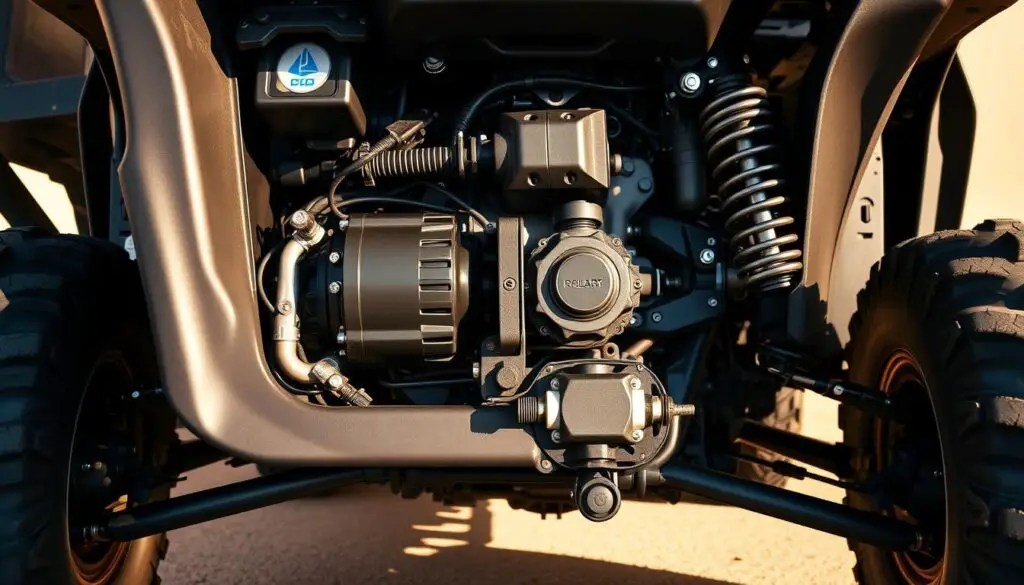The Polaris Ranger 500 is a versatile and reliable UTV designed for a variety of tasks, from agricultural work to recreational activities. However, like any vehicle, it can experience issues that affect its performance. Troubleshooting is an essential skill for owners and operators to identify and fix problems efficiently.
Regular UTV maintenance is crucial to prevent engine problems and other issues. This article aims to provide a comprehensive guide to troubleshooting Polaris Ranger 500 issues, helping you to keep your vehicle in optimal condition.
Key Takeaways
- Understanding the basics of UTV maintenance
- Identifying common engine problems
- Troubleshooting techniques for the Polaris Ranger 500
- Tips for keeping your UTV in optimal condition
- Best practices for UTV troubleshooting
Understanding Your Polaris Ranger 500
To effectively troubleshoot your Polaris Ranger 500, it’s crucial to understand its key components and systems. The Polaris Ranger 500 is a versatile UTV designed for various tasks, from recreational riding to utility work. Its performance and reliability depend on the proper functioning of several critical systems.
Key Components and Systems
The Polaris Ranger 500 consists of several key components and systems that work together to provide its functionality. The engine is the heart of the vehicle, providing the power needed for movement and operation. The transmission system transfers this power to the wheels, while the electrical system powers essential functions like lighting and ignition. Understanding these components is vital for effective Polaris Ranger 500 maintenance.

| Component | Function | Troubleshooting Tips |
|---|---|---|
| Engine | Provides power | Check oil levels, look for leaks |
| Transmission | Transfers power to wheels | Check for unusual noises, slipping |
| Electrical System | Powers lighting, ignition | Check battery, fuses, wiring |
Essential Tools for Troubleshooting
Having the right tools is essential for effective troubleshooting of your Polaris Ranger 500. A multimeter is crucial for diagnosing electrical issues, while a compression tester helps identify engine problems. Other essential tools include a set of wrenches and sockets, pliers, and a repair manual specific to your vehicle. These tools will help you perform basic diagnostics and repairs.
Engine Problems and Solutions
Troubleshooting engine problems is crucial for maintaining the performance of your Polaris Ranger 500. Engine issues can manifest in various ways, including starting problems, power loss, and unusual noises. Understanding the root cause of these issues is key to applying the correct fix.
Starting Issues and No-Start Conditions
Starting issues are a common problem with the Polaris Ranger 500. If your vehicle won’t start, it’s essential to methodically diagnose the issue. Begin by checking the basics: ensure the battery is fully charged and the connections are clean and secure.
Fuel System Checks
A faulty fuel system can prevent your Polaris Ranger 500 from starting. Check the fuel level, ensure the fuel filter is clean, and inspect the fuel lines for any signs of damage or blockage. Regular maintenance of the fuel system can prevent many starting issues.
Ignition System Diagnosis
The ignition system is another critical area to inspect if your Polaris Ranger 500 won’t start. Check the spark plugs for wear, ensure the ignition coil is functioning correctly, and verify that the spark plug wires are in good condition. A faulty ignition system can often be the culprit behind starting issues.
Power Loss and Rough Running
If your Polaris Ranger 500 is experiencing power loss or running rough, it could be due to several factors. Check the air filter for blockages, inspect the fuel system for any issues, and ensure the spark plugs are firing correctly. Addressing these potential causes can help restore your vehicle’s performance.

Unusual Engine Noises and Vibrations
Unusual engine noises or vibrations can indicate a range of problems, from loose belts to more serious engine damage. Inspect the engine mounts, check for any loose components, and listen for unusual sounds that could indicate worn or failing parts. Prompt diagnosis is crucial to prevent minor issues from becoming major repairs.
By systematically addressing engine problems, you can identify and fix issues before they become more severe. Regular maintenance and inspections are key to keeping your Polaris Ranger 500 running smoothly.
Electrical System Troubleshooting
A well-functioning electrical system is crucial for the operation of your Polaris Ranger 500, and troubleshooting it involves checking several critical components. Electrical issues can manifest in various ways, from starting problems to faulty accessories, making a systematic approach essential for diagnosis.
Battery and Charging System Issues
The battery and charging system are fundamental to the electrical system. Issues here can lead to a range of problems, including failure to start and dim or flickering lights.
Testing Battery Health
To test battery health, use a multimeter to measure the voltage. A fully charged battery should read around 12.6 volts. If the voltage is significantly lower, it may indicate a discharged or failing battery.
Alternator and Regulator Diagnosis
The alternator and voltage regulator work together to charge the battery and power the electrical system. Testing these components involves checking the output voltage of the alternator and ensuring the regulator is functioning correctly.
Alternator Testing Steps:
- Measure the voltage across the battery terminals with the engine running.
- The voltage should be between 13.5 and 14.5 volts.
- If the voltage is outside this range, the alternator or regulator may be faulty.
Faulty Switches, Sensors, and Connections
Faulty switches, sensors, and connections can cause intermittent or persistent electrical issues. Inspecting these components for signs of wear or damage is crucial.
Lighting and Accessory Failures
Failures in lighting and accessories can be due to blown fuses, faulty wiring, or component failure. Checking the fuse box and inspecting wiring for damage can help identify the issue.
| Symptom | Possible Cause | Solution |
|---|---|---|
| Dim or Flickering Lights | Low Battery Voltage or Faulty Alternator | Check Battery Health, Test Alternator Output |
| No Start Condition | Discharged Battery or Faulty Starter | Check Battery Voltage, Inspect Starter Motor |
| Accessory Failure | Blown Fuse or Faulty Wiring | Inspect Fuse Box, Check Wiring for Damage |
By systematically checking each component of the electrical system, you can identify and fix issues, ensuring your Polaris Ranger 500 operates reliably.
Transmission and Drive Train Issues
Understanding the common issues related to the transmission and drive train of the Polaris Ranger 500 is essential for effective troubleshooting. These components are crucial for the vehicle’s performance, and problems can lead to significant operational issues.
Shifting Problems and Solutions
Shifting problems in the Polaris Ranger 500 can be caused by a variety of factors, including worn or damaged gear components, improper adjustment of the transmission, or issues with the shift linkage. To troubleshoot, start by checking the transmission fluid level and condition. If the fluid is low or dirty, it may be causing the shifting problems. For more complex issues, consulting a professional mechanic or referring to resources like troubleshooting guides for similar vehicles can provide valuable insights.
- Check transmission fluid level and condition.
- Inspect gear components for wear or damage.
- Adjust or repair the shift linkage as necessary.
Belt and Clutch Malfunctions
The belt and clutch system in the Polaris Ranger 500 is critical for its operation. Malfunctions can occur due to wear, misalignment, or improper maintenance. Regular inspection of the belt for signs of wear, such as cracking or fraying, is crucial. Clutch issues may arise from worn clutch components or improper adjustment. Ensuring that the clutch is properly adjusted and replacing worn components can resolve many issues.
- Regularly inspecting the belt for wear.
- Checking clutch components for wear or damage.
- Adjusting the clutch according to the manufacturer’s specifications.
Differential and Axle Troubleshooting
Issues with the differential and axles can cause significant problems, including unusual noises or vibrations. Troubleshooting these issues involves checking for leaks, inspecting the differential fluid level and condition, and examining the axles for damage or wear. Regular maintenance, such as changing the differential fluid, can help prevent many issues.
- Check for leaks around the differential.
- Inspect the differential fluid level and condition.
- Examine axles for signs of damage or wear.
By addressing these common transmission and drive train issues, Polaris Ranger 500 owners can maintain their vehicle’s performance and extend its lifespan.
Polaris Ranger 500 Troubleshooting: Common Issues and Fixes
Understanding the common issues that affect the Polaris Ranger 500 is crucial for effective troubleshooting. This section will cover suspension and steering problems, brake system failures, and cooling system overheating issues, providing you with the knowledge to identify and fix these problems.
Suspension and Steering Problems
Suspension and steering issues can significantly impact the handling and stability of your Polaris Ranger 500. Common symptoms include uneven tire wear, loose steering, or a bumpy ride. To troubleshoot, check the suspension components for wear or damage, and ensure that the steering column is properly aligned.
- Inspect the shock absorbers for leaks or damage.
- Check the ball joints and control arms for wear.
- Verify that the steering rack is securely mounted.
Brake System Failures
Brake system failures can be hazardous, so it’s essential to address any issues promptly. Common symptoms include spongy brake pedals, grinding noises, or uneven braking. To troubleshoot, inspect the brake pads for wear, check the brake fluid level, and ensure that the brake rotors are not warped.
Cooling System Overheating Issues
Cooling system overheating can cause significant damage to your Polaris Ranger 500’s engine. Common symptoms include high coolant temperatures, leaks, or a malfunctioning thermostat. To troubleshoot, check the coolant level, inspect the radiator hoses for damage, and ensure that the cooling fan is functioning correctly.
- Check the coolant level regularly to prevent overheating.
- Inspect the radiator for damage or corrosion.
- Verify that the thermostat is functioning correctly.
Conclusion
Regular maintenance is crucial for the optimal performance and longevity of your Polaris Ranger 500. By following the troubleshooting guide outlined in this article, you can identify and address common issues before they become major problems.
Effective Polaris Ranger 500 maintenance involves checking and maintaining key components such as the engine, transmission, electrical system, and brakes. This proactive approach helps prevent breakdowns and ensures your UTV remains reliable and efficient.
By applying the knowledge gained from this UTV troubleshooting guide, you can keep your Polaris Ranger 500 running smoothly and extend its lifespan. Regular checks and timely repairs are essential for maintaining the performance and reliability of your vehicle.
Staying on top of maintenance and troubleshooting will help you get the most out of your Polaris Ranger 500, whether you’re using it for work or recreation.
FAQ
What are the most common issues with the Polaris Ranger 500?
Common issues with the Polaris Ranger 500 include engine problems, electrical system issues, transmission and drive train problems, suspension and steering issues, brake system failures, and cooling system overheating.
How do I troubleshoot engine starting issues on my Polaris Ranger 500?
To troubleshoot engine starting issues, check the fuel system, ignition system, and battery health. Ensure the fuel tank is not empty, the fuel filter is clean, and the spark plugs are in good condition.
What are the signs of a faulty alternator on a Polaris Ranger 500?
Signs of a faulty alternator include a dead battery, dim or flickering lights, and malfunctioning electrical accessories. Use a multimeter to test the alternator’s voltage output.
How do I diagnose transmission shifting problems on my Polaris Ranger 500?
To diagnose transmission shifting problems, check the transmission fluid level, inspect the clutch and belt for wear, and ensure the shift linkage is properly adjusted.
What causes cooling system overheating issues on a Polaris Ranger 500?
Cooling system overheating can be caused by low coolant levels, a faulty thermostat, or a malfunctioning radiator fan. Check the coolant level, inspect the thermostat, and ensure the radiator fan is working properly.
How do I test the battery health on my Polaris Ranger 500?
To test the battery health, use a multimeter to measure the battery voltage, perform a load test, and check the battery terminals for corrosion.
What are the symptoms of a faulty sensor on a Polaris Ranger 500?
Symptoms of a faulty sensor include erratic engine behavior, poor performance, and warning lights on the dashboard. Check the sensor connections and consult the owner’s manual for troubleshooting guides.
How do I troubleshoot brake system failures on my Polaris Ranger 500?
To troubleshoot brake system failures, check the brake fluid level, inspect the brake pads and rotors for wear, and ensure the brake calipers are functioning properly.


